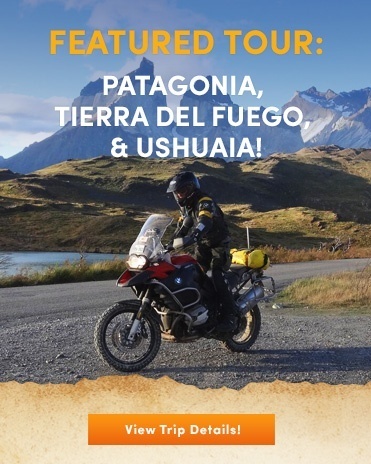Maybe you've done water crossings before, or your luck as an adventure rider has yet to produce the opportunity. Whatever the case, there are at least 7 important points to consider before you go riding through any river, stream, puddle, or whatever you come across! Please take advantage of the notes below, or the video review on this link.
7 Important Things to Consider
 1) Let Your Bike Cool Down, First!
1) Let Your Bike Cool Down, First!
We've all heard the warnings and perhaps some of you have even seen it happen: Cold water hitting extremely hot metal could result in damage or cracking motorcycle parts.
This being said, it's best to let your engine and other motorcycle parts cool down just a bit before entering extremely cold water. Brake rotors on cars are well-known for warping after hitting cold puddles, so it's fair to say the same reaction could take place with a motorcycle brake discs. If you hurried up to a cold glacier-fed water crossing and suddenly hit the brakes, or perhaps let your engine idle for a few minutes while contemplating the decision to cross, it's best to wait until a more "moderate" difference in temperatures exists between said parts and the water. Although it's rare or unlikely to sustain damage from such an encounter, it is a possibility.
2) Check How Deep the Water Is
From a distance or certain angles, you might not be able to know just how deep a body of water is. That being said, it's best to get off the bike, walk out into the water, and determine just how deep or "unforgiving" your projected path of travel is. We take risks every day as motorcycle riders, and some risks like water crossings tend to stress the financial side of things more than safety concerns. See how the depth of the water relates to Point #4 just ahead!
3) Consider the Strength of the Water Current
If it's a large, standing puddle of non-moving, this doesn't apply; but a strongly flowing river crossing is an entirely different situation. Have a good look and do what you can to feel the current before riding out into it. Then imagine the incredible power that water (at over 8lbs/3kg per gallon) would have as it's slamming into the side of your motorcycle. Would you be able to keep the bike upright against that force? Also keep in mind that if you have to lean your bike into the current in order to stay upright, the current will be "lifting" your bike slightly, lessening your traction and contact with the ground. On top of what might already be a slippery surface under the water, and one where your feet could slip as well, try to determine in advance if crossing such extreme current is realistic or not.
 4) Know Where Your Air Intake Is
4) Know Where Your Air Intake Is
Even the BMW R1200GS, the longtime title holder of "world's most popular adventure bike" doesn't offer much in terms of how deep water can be before reaching the air intake point (until the 2013 model year when the Liquid Cooled version of the boxer engine also meant BMW also raised the air intake point.) The point is, you should know for sure where the point is that your engine breathes from, as submerging the motorcycle in water up to that point will not be a good idea. (Hopefully we don't have to explain that engines don't stay running if they're gulping water. Photo above/right shows how Ian's engine was choking after just brushing the top of the river in Patagonia.)
5) Choose: Sitting vs. Standing Position
As is covered in our Free Whitepaper Download about Sitting vs. Standing while riding, there are Pro's and Con's to both positions during water crossings as well. When seated, you'll be able to tap the ground with your feet if you need to regain balance, but your visibility of what lies ahead isn't as good as when you're standing. Then again, what if you're riding along in the standing position and don't see a log hidden under the water at a 45-degree angle from which you're traveling? Even at a mere 2-3 mph, it's quite unlikely you'll be able to keep from falling (unless you were able to tap your foot down to maintain balance.) Again, keep in mind the Pro's and Con's of both riding positions, and don't just think about what looks cool for the camera!
 6) Clear Your Engine Carefully If Needed
6) Clear Your Engine Carefully If Needed
Did your bike end up in the water? Don't feel bad, you're probably not alone.
If your engine stopped running and there's even a chance your engine's combustion chamber(s) consumed any water, don't just push the button and try to start it right away as you could destroy your engine. What's known as "hydrolock" means you've got a significant amount of water above the pistons, (in the combustion chambers) and you'll want to clear that water out safely before cranking the engine over with your electric start. Take the spark plug(s) out, put the motorcycle in gear, and rotate the rear wheel by either pushing the bike or spinning it by hand. You'll see water spraying out the spark plug holes as the engine turns through its cycle, and after a good 10-15 cycles, it should be ready to reassemble and run again. (Be sure that your airbox is empty as well!) You'll want to inspect your oil situation at the same time. Is it white and "milky?" That means water got mixed in with the oil, and should be changed immediately, or at least as soon as possible.
7) Check Your Brake Fluid & Pump Your Brakes
It's quite unlikely that water would get into your brake lines or reservoirs, but still a good idea to be aware of this possibility before proceding. In short, do an entire brake system inspection and make sure proper pressure is still applicable through your hand and foot levers before proceeding. Much the same, be sure to pump the brakes and dry-off the brake pads and calipers a bit, as water can obviously keep your brakes from functioning 100%. So don't just pull out into traffic without checking your brakes!
As always, be sure to check our "Free Motorcycle Travel Info" page on www.rideadv.com, download anything that will help you and your adventure travel plans, and let us know when we can help make your motorcycle travel wishes a reality!


